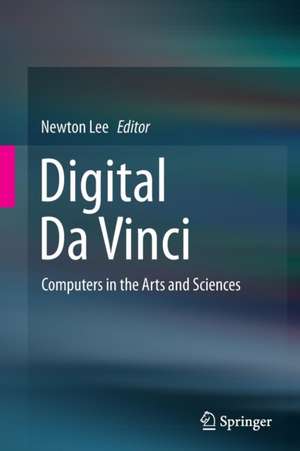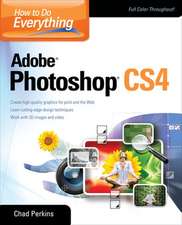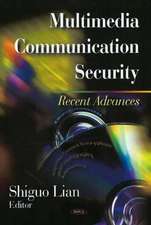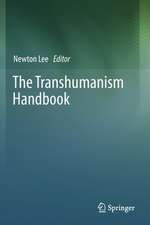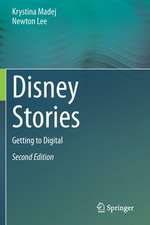Digital Da Vinci: Computers in the Arts and Sciences
Editat de Newton Leeen Limba Engleză Paperback – 17 sep 2016
| Toate formatele și edițiile | Preț | Express |
|---|---|---|
| Paperback (2) | 314.98 lei 38-44 zile | |
| Springer – 17 sep 2016 | 314.98 lei 38-44 zile | |
| Springer – 3 sep 2016 | 332.06 lei 6-8 săpt. | |
| Hardback (2) | 326.66 lei 38-44 zile | |
| Springer – 2 aug 2014 | 326.66 lei 38-44 zile | |
| Springer – 12 apr 2014 | 395.09 lei 6-8 săpt. |
Preț: 314.98 lei
Preț vechi: 393.73 lei
-20% Nou
Puncte Express: 472
Preț estimativ în valută:
60.27€ • 62.93$ • 49.77£
60.27€ • 62.93$ • 49.77£
Carte tipărită la comandă
Livrare economică 11-17 aprilie
Preluare comenzi: 021 569.72.76
Specificații
ISBN-13: 9781493949151
ISBN-10: 1493949152
Pagini: 292
Ilustrații: XIX, 292 p. 137 illus., 107 illus. in color.
Dimensiuni: 155 x 235 x 17 mm
Greutate: 0.44 kg
Ediția:Softcover reprint of the original 1st ed. 2014
Editura: Springer
Colecția Springer
Locul publicării:New York, NY, United States
ISBN-10: 1493949152
Pagini: 292
Ilustrații: XIX, 292 p. 137 illus., 107 illus. in color.
Dimensiuni: 155 x 235 x 17 mm
Greutate: 0.44 kg
Ediția:Softcover reprint of the original 1st ed. 2014
Editura: Springer
Colecția Springer
Locul publicării:New York, NY, United States
Cuprins
From a Pin-Up Girl to Star Trek's Holodeck: Artificial Intelligence and Cyborgs.- Experimental Creative Practices.- Repeating Circles, Changing Stars: Learning from the Medieval Art of Visual Computation.- Brain, Technology and Creativity, Brainart: A BCI-Based Entertainment Tool to Enact Creativity and Create Drawing From Cerebral Rhythms.- Video Ergo Sum: An Artist's Thoughts on Inventing with Computer Technology in the Creation of Artworks.- Wasting Time? Art, Science and New Experience, Examining the Artwork, Know More (House of Commons).- The Information Train.- The Quartic Process Model for Developing Serious Games: 'Green My Place' Case Study.- 3-D Manufacturing: The Beginning of Common Creativity Revolution.- Recursive Digital Fabrication of Trans-Phenomenal Artifacts.- Human-Robotic Interaction in Prepare Environments: Introducing an Element of Surprise by Reassigning Identities in Familiar Objects.- The Message of Media Machines.
Notă biografică
Dennis Anderson is Chair and Professor of Management and Information Technology at St. Francis College. Prior to this appointment he was a Professor of Information Systems & Computer Science and served as Associate Dean at Pace University. He is a strong advocate of technology-enhanced learning, emerging technologies, sustainable technologies, and knowledge entrepreneurship. He also has taught at NYU, City University of New York, and Pace University. Dennis received his Ph.D., M.Phil. and Ed.M. from Columbia University. In addition, he holds an M.S. in Computer Science from NYU's Courant Institute of Mathematical Sciences.
Keith Armstrong has specialized for 18 years in collaborative, hybrid, new media works with an emphasis on innovative performance forms, site-specific electronic arts, networked interactive installations, alternative interfaces, public arts practices and art-science collaborations. His ongoing research focuses on how scientific and philosophical ecologies can both influence and direct the design and conception of networked, interactive media artworks. Keith's artworks have been shown and profiled extensively both in Australia and overseas and he has been the recipient of numerous grants from the public and private sectors. He was formerly an Australia Council New Media Arts Fellow, a doctoral and Postdoctoral New Media Fellow at QUT's Creative Industries Faculty and a lead researcher at the ACID Australasian Cooperative Research Centre for Interaction Design. He is currently a part-time Senior Research Fellow (2 days pw.) at QUT and an actively practicing freelance new media artist.
Stephen Barrass is a researcher and academic at the University of Canberra where he lectures in Digital Design and Media Arts in the Faculty of Artsand Design. He holds a B.E. in Electrical Engineering from the University of New South Wales (1986) and a Ph.D. titled Auditory Information Design from the Australian National University (1997). He was a Post-Doctoral Fellow at the Fraunhofer Institute for Media Kommunication in Bonn (1998) and Guest Researcher in Sound Design and Perception at IRCAM in Paris (2009).
Nathan Cohen is a professional artist exhibiting internationally for over 25 years, including solo shows at Annely Juda Fine Art, London; Museum Mondriaanhuis, Holland; Tokyo Gallery, Japan and many other venues worldwide. His interdisciplinary research in art and science embraces neuroscience, optics and augmented reality technologies resulting in recent interactive art installations exhibited at Ars Electronica, Austria (Hybrid Ego 2008), the Aisho Miura gallery (Intangible Spaces 2010), Japan and University College London (Another Way of Seeing 2013). In collaboration with Tachi Lab (Tokyo) and researchers in Japan and the UK he creates artworks that challenge spatial perception, incorporating motion sensing and real-time projection into 2 and 3-dimensional constructions created to give the impression of multi-layered spaces. In 2011 Nathan Cohen established the first Masters program in Art and Science (Central Saint Martins, University of the Arts London) and is currently Director. His professional activities also embrace publishing, directing an archive, curating exhibitions internationally and writing. He was a recipient of the Vordemberge-Gildewart Award in 1994 and studied at the Slade School of Fine Art, UCL (BA Hons.) and Chelsea School of Art (MA), London.
Benjamin Cowley received his Bachelors degree on Information and Communications Technology from Trinity College Dublin,Ireland, in 2003, and subsequently defended his PhD in Computer Science at the University of Ulster, Northern Ireland, in 2009. Initial post-doctoral projects focused on investigating the psycho-physiological correlates of learning in the domain of serious games, in the Centre for Knowledge Innovation and Research at Aalto University, Helsinki. Presently he studies neurofeedback games for attentional disorder therapy at the University of Helsinki. Research interests are in games for learning, cognitive science, and attention as a component of positive psychology.
Roman Danylak is an interactive artist. He completed a Ph.D. at the Creativity and Cognition Studios, University of Technology, Sydney in 2008, specializing in design for gesture and emotions using semiotics. His work, To be or not to be, was featured at Sydney’s Powerhouse Museum. He has presented at numerous international academic conferences in Sweden, Japan, USA, Italy, UAE, France and Germany. He has lectured and designed online curriculum for Stockholm University in Interactive Art. His work began with Metamorph (1996), a prototype of interactive performance, and was the one of the first Australian works to be featured on the World Wide Web. He has also worked for the Australian National Playwrights’ Centre developing scripts to professional performance level and has published many critical reviews on art and design. As an artist he has worked in film, TV and theatre as writer, musician and performer.
Raffaella Folgieri, Ph.D. in Computer Science, is Assistant Professor in Computer Skills at the Faculty of Political Science and of Information Technology at the Faculty of Political Science and at the Faculty of Medicine (Medical and Pharmaceutical Biotechnologies). She also teaches Information Technology Representationof Knowledge in the post-degree course in Cognitive Science and Decision Making, Virtual Reality in the Information Technology and Digital Communication degree course and Project Management at the Faculty of Mathematics, Physics, and Natural Sciences of the University of Milan. Member of Italian Society of Engineering and of SIREN (Italian Neural Networks Society), she has published her research in several journal articles (main fields of interests: Brainomics; Brain Computer Interfaces; Virtual Reality; Bioinformatics; Machine Learning and AI; Quality assessment in complex software development; e-learning). Her work explores some of the central issues in cognitive research such as how people move from skilled performance to problem solving, how a person learns, manages errors, interprets visual stimuli, and communicates. She coordinates the research group Beside, focused on interpersonal, machine-machine and brain-machine communication mediated by technology, and ExCog (jointly with Prof. Lucchiari), aiming to study MIND in all its complexity and all possible shapes.
Marco Granato is currently a post-degree student in Cognitive Science. He has a degree in Computer Science from the University of Milan. He is a member of the research groups Beside and ExCog (Extended Cognition) at the University of Milan, under the supervision of Prof. Folgieri. His research interests cover applied research on the brain and computer interaction.
Daniele Grechi is a research fellow in the Department of Naval, Electrical, Electronic and TelecommunicationsEngineering of the Polytechnical School, at the University of Genoa. He received a Master Degree in Banking and Finance from the University of Insubria (Varese) and he worked for the IUSS of Pavia for a software banking risk project. He is also contract professor of Statistics in the Department of Economics of the University of Insubria. His current research includes software engineering, software metrics, software development methodology and statistical software analysis.
Newton Lee is founding director of the Woodbury University Digital Media Lab and adjunct professor of Media Technology at the School of Media, Culture & Design. He is also CEO of Newton Lee Laboratories LLC, president of the Institute for Education, Research, and Scholarships, and founding editor-in-chief of ACM Computers in Entertainment. Previously, he was a research scientist at AT&T Bell Laboratories, senior producer and engineer at The Walt Disney Company, research staff member at the Institute for Defense Analyses, and research scientist at Virginia Tech Library Systems. Lee graduated Summa Cum Laude from Virginia Tech with a B.S. and M.S. degree in Computer Science, and he earned a perfect GPA from Vincennes University with an A.S. degree in Electrical Engineering and an honorary doctorate in Computer Science. He is the co-author of Disney Stories: Getting to Digital; the author of the Total Information Awareness book series including Facebook Nation and Counterterrorism and Cybersecurity; and the editor of the Digital Da Vinci book series including Computers in Music and Computers in the Arts and Sciences.
Claudio Lucchiari is Assistant professor in Cognitive Pscyhology, University of Milan. He has a degree in psychology and a Ph.D. in Communication Psychology. He was tutor and professor ofcognitive psychology at the Catholic University of Milan and the University of Urbino (2003-2006). He worked as neuro-psychologist and cognitive psychologist at the Neurological National Institute of Milan (2002-2006), where he focused on the neurological basis of thought, medical decision making, shared decisions, doctor-patient communication and health related quality of life. Since 2006, he has been a lecturer at the University of Milan and a member of the IRIDe (Interdisciplinary Research and Intervention on Decision) research centre. His research activities focus on decision making and the application of cognitive science in various fields. In particular, he conducts research on medical decision making, psychoeconomics, neuroeconomics (risk perception, emotional and neuro-marketing), the neural correlates of decisions and creativity. Furthermore he is developing a BCI-based neuro-cognitive program aimed at empowering cognitive performances.
Robert Niewiadomski is an educator with the NYCDOE and a Teach For America corps member. He earned a B.A in Philosophy from Columbia University and is currently pursuing graduate studies both at Columbia and Fordham University. At Columbia, he investigated ethical aspects of gene patenting and presented at several philosophy conferences. Prior to his arrival at Columbia, he studied at the University of Warsaw and participated in the European Union sponsored Youth Program in the UK. Robert's main areas of interest include philosophy of science as well as ethical aspects of medical and technological advances.
Mine Özkar is a visiting professor at MIT for Spring 2013 and an associate professor of architecture at Istanbul Technical University, where she also serves on the executive committee for the Program in Computational Design. She earned her SMArchS in design inquiry and her PhD in design andcomputation from MIT. In some of her previous work, she has interpreted the history and theory of progressive pedagogy in art and design from a computational perspective. Her current research focuses on shape representation, spatial computation, and computational design methods. She also publishes on the theory and practice of foundational design education and the ongoing global and local curriculum reforms in architectural education. She recently guest-edited the 2012 ACM SIGGRAPH/Leonardo ISAST Special Issue and co-edited a book titled Shaping Design Teaching.
Gavin Sade is an artist, designer and researcher in the field of interactive computational media, with a background in music and sonology. He is currently the Head of Interactive and Visual Design in the Creative Industries Faculty at the Queensland University of Technology. Gavin holds a Bachelor of Music (Sonology) from the Queensland Conservatorium of Music, and a PhD in interactive media arts and sustainability. He has been creating interactive media systems and electronic art since 1990 when he began working with electronic music group Vision 4/5 and later with Keith Armstrong and the Transmute Collective. In 2003 he formed Kuuki (http://kuuki.com.au), a creative media collective, and has since lead the production of a number of high profile electronic artworks that have been exhibited in international settings, such as the 2011 International Symposium of Electronic Art in Istanbul and the Museum of Contemporary Art Taipei. Gavin's practice is guided by an ecological philosophy inspired by vegetarianism and the critical design philosophy of defuturing, and is a mix of electronic art and critical design.
Diomidis D. Spinellis is a professor at the Department of Management Science and Technology at the Athens University of Economics and Business in Greece.Previously, he was the General Secretary of Information Systems at the Greek Ministry of Finance. He is a member of the IEEE Software editorial board, contributing the Tools of the Trade column. He is a four-time winner of the International Obfuscated C Code Contest. Spinellis holds a Master of Engineering degree in Software Engineering and a Ph.D. in Computer Science from Imperial College London. He has authored and coauthored Code Reading, Code Quality, and Beautiful Architecture.
Mari Velonaki has worked as a researcher in the field of interactive installation art since 1997. Mari has created interactive installations that incorporate movement, speech, touch, breath, electrostatic charge, artificial vision and robotics. In 2003 Mari’s practice expanded to robotics, when she initiated and led a major Australian Research Council art/science research project ‘Fish–Bird: Autonomous Interactions in a Contemporary Arts Setting 2004-2007’ in collaboration with roboticists at the Australian Centre for Field Robotics. In 2006 she co- founded, with David Rye, the Centre for Social Robotics, a centre dedicated to inter- disciplinary research into human-robot interaction in spaces that incorporate the general public. In 2007 Mari was awarded an Australia Council for the Arts Visual Arts Fellowship. In 2009 she was awarded an Australia Research Council Queen Elizabeth II Fellowship (2009–2013) for the creation of a new robot in order to develop an understanding of the physicality that is possible and acceptable between a human and a robot. Mari is currently an Associate Professor and the director of a new lab, the Creative Robotics Lab, at the National Institute of Experimental Arts at the College of Fine Arts, The University of New South Wales. Mari’s artworks have been exhibited worldwide.
Keith Armstrong has specialized for 18 years in collaborative, hybrid, new media works with an emphasis on innovative performance forms, site-specific electronic arts, networked interactive installations, alternative interfaces, public arts practices and art-science collaborations. His ongoing research focuses on how scientific and philosophical ecologies can both influence and direct the design and conception of networked, interactive media artworks. Keith's artworks have been shown and profiled extensively both in Australia and overseas and he has been the recipient of numerous grants from the public and private sectors. He was formerly an Australia Council New Media Arts Fellow, a doctoral and Postdoctoral New Media Fellow at QUT's Creative Industries Faculty and a lead researcher at the ACID Australasian Cooperative Research Centre for Interaction Design. He is currently a part-time Senior Research Fellow (2 days pw.) at QUT and an actively practicing freelance new media artist.
Stephen Barrass is a researcher and academic at the University of Canberra where he lectures in Digital Design and Media Arts in the Faculty of Artsand Design. He holds a B.E. in Electrical Engineering from the University of New South Wales (1986) and a Ph.D. titled Auditory Information Design from the Australian National University (1997). He was a Post-Doctoral Fellow at the Fraunhofer Institute for Media Kommunication in Bonn (1998) and Guest Researcher in Sound Design and Perception at IRCAM in Paris (2009).
Nathan Cohen is a professional artist exhibiting internationally for over 25 years, including solo shows at Annely Juda Fine Art, London; Museum Mondriaanhuis, Holland; Tokyo Gallery, Japan and many other venues worldwide. His interdisciplinary research in art and science embraces neuroscience, optics and augmented reality technologies resulting in recent interactive art installations exhibited at Ars Electronica, Austria (Hybrid Ego 2008), the Aisho Miura gallery (Intangible Spaces 2010), Japan and University College London (Another Way of Seeing 2013). In collaboration with Tachi Lab (Tokyo) and researchers in Japan and the UK he creates artworks that challenge spatial perception, incorporating motion sensing and real-time projection into 2 and 3-dimensional constructions created to give the impression of multi-layered spaces. In 2011 Nathan Cohen established the first Masters program in Art and Science (Central Saint Martins, University of the Arts London) and is currently Director. His professional activities also embrace publishing, directing an archive, curating exhibitions internationally and writing. He was a recipient of the Vordemberge-Gildewart Award in 1994 and studied at the Slade School of Fine Art, UCL (BA Hons.) and Chelsea School of Art (MA), London.
Benjamin Cowley received his Bachelors degree on Information and Communications Technology from Trinity College Dublin,Ireland, in 2003, and subsequently defended his PhD in Computer Science at the University of Ulster, Northern Ireland, in 2009. Initial post-doctoral projects focused on investigating the psycho-physiological correlates of learning in the domain of serious games, in the Centre for Knowledge Innovation and Research at Aalto University, Helsinki. Presently he studies neurofeedback games for attentional disorder therapy at the University of Helsinki. Research interests are in games for learning, cognitive science, and attention as a component of positive psychology.
Roman Danylak is an interactive artist. He completed a Ph.D. at the Creativity and Cognition Studios, University of Technology, Sydney in 2008, specializing in design for gesture and emotions using semiotics. His work, To be or not to be, was featured at Sydney’s Powerhouse Museum. He has presented at numerous international academic conferences in Sweden, Japan, USA, Italy, UAE, France and Germany. He has lectured and designed online curriculum for Stockholm University in Interactive Art. His work began with Metamorph (1996), a prototype of interactive performance, and was the one of the first Australian works to be featured on the World Wide Web. He has also worked for the Australian National Playwrights’ Centre developing scripts to professional performance level and has published many critical reviews on art and design. As an artist he has worked in film, TV and theatre as writer, musician and performer.
Raffaella Folgieri, Ph.D. in Computer Science, is Assistant Professor in Computer Skills at the Faculty of Political Science and of Information Technology at the Faculty of Political Science and at the Faculty of Medicine (Medical and Pharmaceutical Biotechnologies). She also teaches Information Technology Representationof Knowledge in the post-degree course in Cognitive Science and Decision Making, Virtual Reality in the Information Technology and Digital Communication degree course and Project Management at the Faculty of Mathematics, Physics, and Natural Sciences of the University of Milan. Member of Italian Society of Engineering and of SIREN (Italian Neural Networks Society), she has published her research in several journal articles (main fields of interests: Brainomics; Brain Computer Interfaces; Virtual Reality; Bioinformatics; Machine Learning and AI; Quality assessment in complex software development; e-learning). Her work explores some of the central issues in cognitive research such as how people move from skilled performance to problem solving, how a person learns, manages errors, interprets visual stimuli, and communicates. She coordinates the research group Beside, focused on interpersonal, machine-machine and brain-machine communication mediated by technology, and ExCog (jointly with Prof. Lucchiari), aiming to study MIND in all its complexity and all possible shapes.
Marco Granato is currently a post-degree student in Cognitive Science. He has a degree in Computer Science from the University of Milan. He is a member of the research groups Beside and ExCog (Extended Cognition) at the University of Milan, under the supervision of Prof. Folgieri. His research interests cover applied research on the brain and computer interaction.
Daniele Grechi is a research fellow in the Department of Naval, Electrical, Electronic and TelecommunicationsEngineering of the Polytechnical School, at the University of Genoa. He received a Master Degree in Banking and Finance from the University of Insubria (Varese) and he worked for the IUSS of Pavia for a software banking risk project. He is also contract professor of Statistics in the Department of Economics of the University of Insubria. His current research includes software engineering, software metrics, software development methodology and statistical software analysis.
Newton Lee is founding director of the Woodbury University Digital Media Lab and adjunct professor of Media Technology at the School of Media, Culture & Design. He is also CEO of Newton Lee Laboratories LLC, president of the Institute for Education, Research, and Scholarships, and founding editor-in-chief of ACM Computers in Entertainment. Previously, he was a research scientist at AT&T Bell Laboratories, senior producer and engineer at The Walt Disney Company, research staff member at the Institute for Defense Analyses, and research scientist at Virginia Tech Library Systems. Lee graduated Summa Cum Laude from Virginia Tech with a B.S. and M.S. degree in Computer Science, and he earned a perfect GPA from Vincennes University with an A.S. degree in Electrical Engineering and an honorary doctorate in Computer Science. He is the co-author of Disney Stories: Getting to Digital; the author of the Total Information Awareness book series including Facebook Nation and Counterterrorism and Cybersecurity; and the editor of the Digital Da Vinci book series including Computers in Music and Computers in the Arts and Sciences.
Claudio Lucchiari is Assistant professor in Cognitive Pscyhology, University of Milan. He has a degree in psychology and a Ph.D. in Communication Psychology. He was tutor and professor ofcognitive psychology at the Catholic University of Milan and the University of Urbino (2003-2006). He worked as neuro-psychologist and cognitive psychologist at the Neurological National Institute of Milan (2002-2006), where he focused on the neurological basis of thought, medical decision making, shared decisions, doctor-patient communication and health related quality of life. Since 2006, he has been a lecturer at the University of Milan and a member of the IRIDe (Interdisciplinary Research and Intervention on Decision) research centre. His research activities focus on decision making and the application of cognitive science in various fields. In particular, he conducts research on medical decision making, psychoeconomics, neuroeconomics (risk perception, emotional and neuro-marketing), the neural correlates of decisions and creativity. Furthermore he is developing a BCI-based neuro-cognitive program aimed at empowering cognitive performances.
Robert Niewiadomski is an educator with the NYCDOE and a Teach For America corps member. He earned a B.A in Philosophy from Columbia University and is currently pursuing graduate studies both at Columbia and Fordham University. At Columbia, he investigated ethical aspects of gene patenting and presented at several philosophy conferences. Prior to his arrival at Columbia, he studied at the University of Warsaw and participated in the European Union sponsored Youth Program in the UK. Robert's main areas of interest include philosophy of science as well as ethical aspects of medical and technological advances.
Mine Özkar is a visiting professor at MIT for Spring 2013 and an associate professor of architecture at Istanbul Technical University, where she also serves on the executive committee for the Program in Computational Design. She earned her SMArchS in design inquiry and her PhD in design andcomputation from MIT. In some of her previous work, she has interpreted the history and theory of progressive pedagogy in art and design from a computational perspective. Her current research focuses on shape representation, spatial computation, and computational design methods. She also publishes on the theory and practice of foundational design education and the ongoing global and local curriculum reforms in architectural education. She recently guest-edited the 2012 ACM SIGGRAPH/Leonardo ISAST Special Issue and co-edited a book titled Shaping Design Teaching.
Gavin Sade is an artist, designer and researcher in the field of interactive computational media, with a background in music and sonology. He is currently the Head of Interactive and Visual Design in the Creative Industries Faculty at the Queensland University of Technology. Gavin holds a Bachelor of Music (Sonology) from the Queensland Conservatorium of Music, and a PhD in interactive media arts and sustainability. He has been creating interactive media systems and electronic art since 1990 when he began working with electronic music group Vision 4/5 and later with Keith Armstrong and the Transmute Collective. In 2003 he formed Kuuki (http://kuuki.com.au), a creative media collective, and has since lead the production of a number of high profile electronic artworks that have been exhibited in international settings, such as the 2011 International Symposium of Electronic Art in Istanbul and the Museum of Contemporary Art Taipei. Gavin's practice is guided by an ecological philosophy inspired by vegetarianism and the critical design philosophy of defuturing, and is a mix of electronic art and critical design.
Diomidis D. Spinellis is a professor at the Department of Management Science and Technology at the Athens University of Economics and Business in Greece.Previously, he was the General Secretary of Information Systems at the Greek Ministry of Finance. He is a member of the IEEE Software editorial board, contributing the Tools of the Trade column. He is a four-time winner of the International Obfuscated C Code Contest. Spinellis holds a Master of Engineering degree in Software Engineering and a Ph.D. in Computer Science from Imperial College London. He has authored and coauthored Code Reading, Code Quality, and Beautiful Architecture.
Mari Velonaki has worked as a researcher in the field of interactive installation art since 1997. Mari has created interactive installations that incorporate movement, speech, touch, breath, electrostatic charge, artificial vision and robotics. In 2003 Mari’s practice expanded to robotics, when she initiated and led a major Australian Research Council art/science research project ‘Fish–Bird: Autonomous Interactions in a Contemporary Arts Setting 2004-2007’ in collaboration with roboticists at the Australian Centre for Field Robotics. In 2006 she co- founded, with David Rye, the Centre for Social Robotics, a centre dedicated to inter- disciplinary research into human-robot interaction in spaces that incorporate the general public. In 2007 Mari was awarded an Australia Council for the Arts Visual Arts Fellowship. In 2009 she was awarded an Australia Research Council Queen Elizabeth II Fellowship (2009–2013) for the creation of a new robot in order to develop an understanding of the physicality that is possible and acceptable between a human and a robot. Mari is currently an Associate Professor and the director of a new lab, the Creative Robotics Lab, at the National Institute of Experimental Arts at the College of Fine Arts, The University of New South Wales. Mari’s artworks have been exhibited worldwide.
Caracteristici
Explores polymathic education through unconventional and creative applications of computer science in the arts and sciences Examines the use of visual computation, 3d printing, social robotics and computer modeling for computational art creation and design Includes contributions from leading researchers and practitioners in computer science, architecture and digital media Includes supplementary material: sn.pub/extras
Recenzii
"I find Newton Lee's writing both educational and intuitive. Given the, oft times, unorthodox ways of the music business, Lee's writing presents a clear and concise view of a creative business so many admire."
-- Brad Mason LeBeau, Founder of PRO MOTION
-- Brad Mason LeBeau, Founder of PRO MOTION
